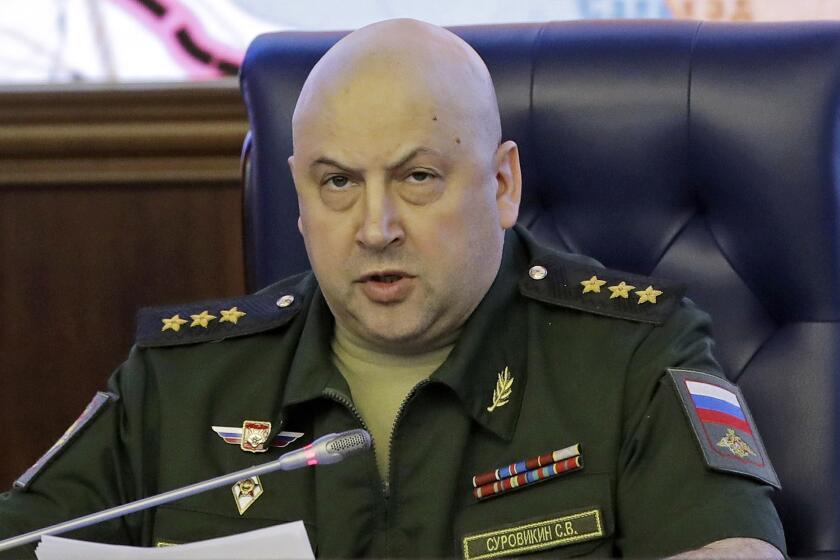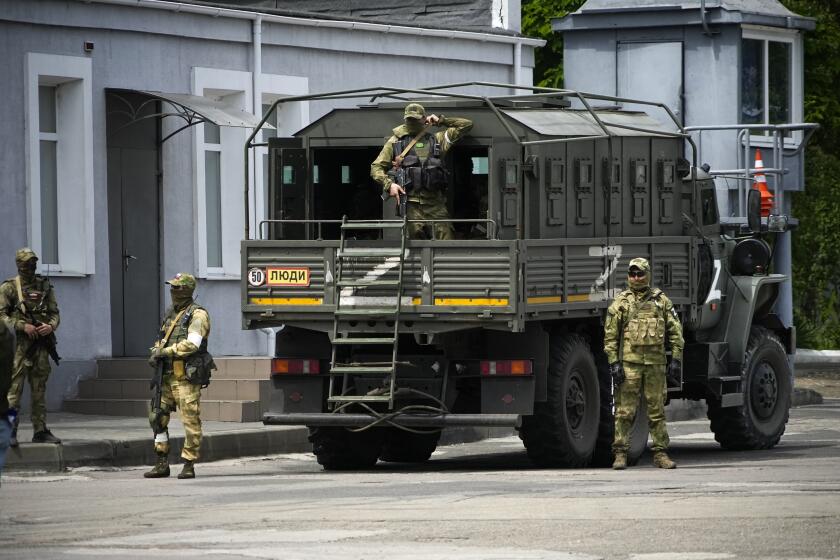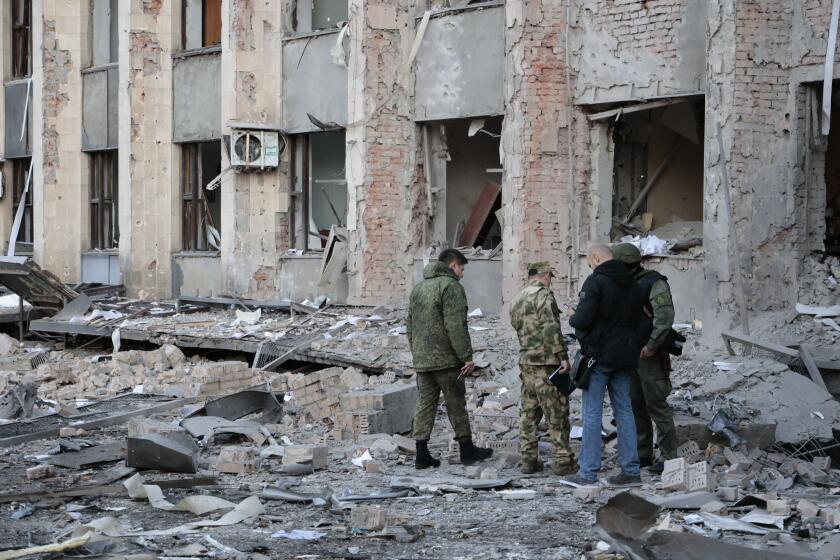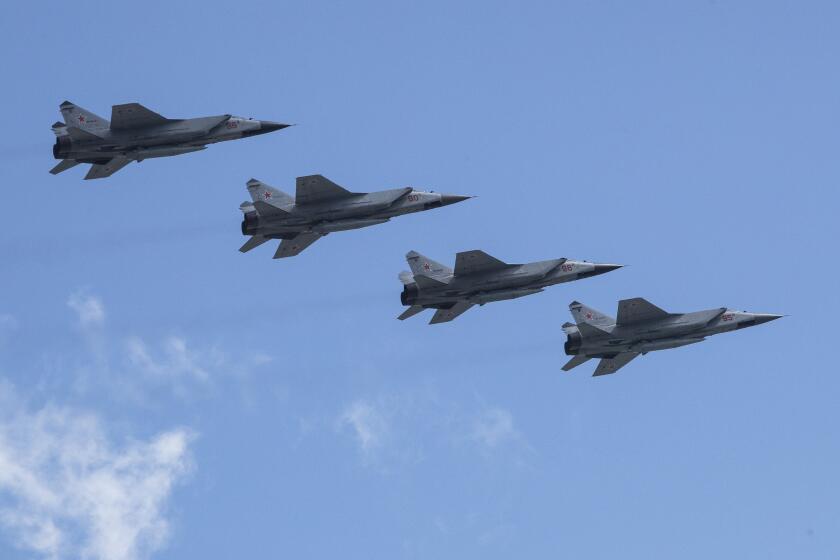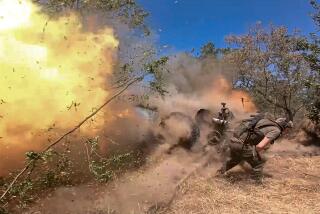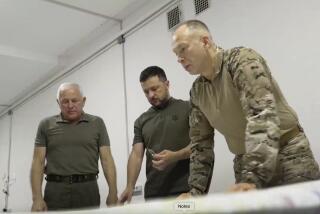Ukrainian forces bombard river crossing; Kherson a fortress
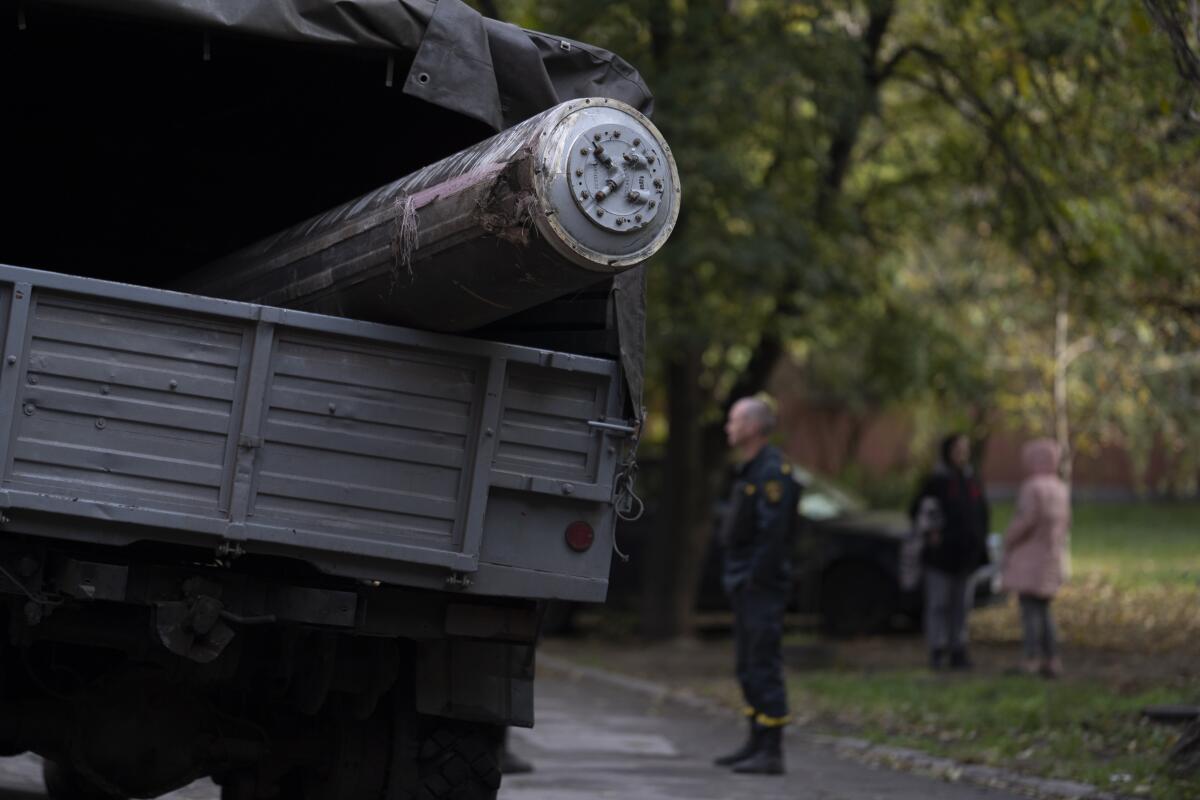
- Share via
KYIV, Ukraine — Ukrainian forces bombarded Russian positions in the occupied and illegally annexed southern Kherson region, targeting resupply routes across a major river while inching closer Friday to a full assault on one of the first urban areas Russia captured after invading the country.
Russian-installed officials were reported desperately trying to turn the city of Kherson, a prime objective for both sides because of its key industries and major river and sea port, into a fortress while attempting to evacuate tens of thousands of residents.
The Kremlin poured as many as 2,000 draftees into the Kherson region — one of four Moscow illegally annexed and put under Russian martial law — to replenish losses and strengthen front-line units, according to the Ukrainian army’s general staff.
The Dnieper River figures prominently in the regional battle because it serves critical functions — crossings for supplies, troops and civilians; drinking water for southern Ukraine and the annexed Crimean Peninsula; and power generation from a hydroelectric station. Much of the area, including the power station and a canal feeding water to Crimea, is under Russian control.
Kremlin-installed Kherson officials said Ukrainian shelling of a Dnieper River ferry crossing killed two journalists working for a local TV station they set up under occupation. At least two other people were reported killed and 10 members of the broadcast crew and their relatives were wounded, Russia’s Tass news agency reported
Natalia Humeniuk, a spokesperson for Ukraine’s southern operational command, confirmed the Ukrainian military struck the Antonivskyi Bridge near the crossing but only during an overnight curfew Russian-installed officials put in place to avoid civilian casualties.
“We do not attack civilians and settlements,” Humeniuk told Ukrainian television.
Earlier Ukrainian strikes had made the Antonivskyi Bridge inoperable, prompting Russian authorities to set up ferry crossings and pontoon bridges to relocate civilians and transport supplies to their troops in Kherson, which sits on the Dnieper’s western bank.
Gen. Sergei Surovikin is driving Russia’s new military strategy in Ukraine, which includes a barrage of strikes on the country’s infrastructure.
Russian-installed officials are trying to evacuate up to 60,000 people from Kherson for their safety and to allow the military to build fortifications. Ukraine’s military reported Friday that bank employees, medical workers and teachers were relocating as the city’s infrastructure wound down.
“The situation is really difficult,” the deputy head of Kherson’s Kremlin-installed regional administration, Kirill Stremousov, said in a video he posted on Telegram. “Today we are preparing the city of Kherson as a fortress for defense and are ready to defend to the last. Our task is to save people, build defenses and protect the city.”
Kherson, with a prewar population of about 284,000, was one of the first urban areas Russia captured when it invaded Ukraine, and it remains the largest city it holds.
Another flashpoint on the Dnieper River is the Kakhovka dam, which creates a large reservoir, and associated hydroelectric power station, about 44 miles from Kherson city. Each side accuses the other of targeting the facilities. Russian-installed officials claim Ukrainian forces have been attacking the facilities in part to cut the water supply to Crimea.
Ukrainian President Volodymyr Zelensky contends the Russians plan to blow up the dam and power station to unleash 18 million cubic meters (4.8 billion gallons) of water and flood Kherson and dozens of other areas where hundreds of thousands of people live. He told the European Council on Thursday that Russia would then blame Ukraine.
None of the claims could be independently verified.
Defying international law, Russian President Vladimir Putin annexed Ukraine’s Kherson, Luhansk, Donetsk and Zaporizhzhia regions last month even though his forces don’t control all the territory. Putin declared martial law in the regions as of Thursday to assert Russian authority in the face of military setbacks and strong international criticism.
In the Donetsk region, two people were killed in the last 24 hours after Russian forces shelled the city of Bakhmut, regional Gov. Pavlo Kyrylenko said. Russian troops have been unable to advance toward the city for more than a month.
Residents who have left the occupied Black Sea port city of Kherson tell of heavy-handed efforts by Russia to establish permanent control.
Nine people were wounded in two Russian attacks in the city of Kharkiv, the capital of eastern Ukraine’s recently reclaimed Kharkiv region, according to regional Gov. Oleh Sinegubov. In the city of Zaporizhzhia, a Russian S-300 missile strike Friday wounded three people and damaged a residential building, a school and infrastructure facilities, Ukrainian authorities said.
“Each strike won’t scare anyone. It will make us stronger,” said acting administrative chief Volodymyr Hrianysty of the Dniprovskyi District.
In an apparent effort to keep hostilities from spinning out of control, U.S. Secretary of Defense Lloyd J. Austin III on Friday reached out to Russian Defense Minister Sergei K. Shoigu in the two men’s first phone call since May 13. U.S. defense officials have said that, for some time, the Russians had not responded to U.S. efforts to set up calls.
Pro-Kremlin officials blame Ukraine for a rocket attack in Donetsk while Russia is blamed for striking a city across from a nuclear power plant.
Russia’s deployment of aircraft and troops to airbases in Belarus raised the specter of another front on Ukraine’s northern border, although Belarusian President Alexander Lukashenko said Friday: “We’re not going anywhere today ... If you do not want to fight with us, then we will not, there will be no war.”
The Ukrainian army’s general staff has warned that Belarus could attack to cut supply routes of Western weapons and equipment. Belarus’ intervention could also divert Ukraine’s resources and weaken its southern counteroffensive.
While prospects for peace appear slim, the Kremlin insisted Friday that Putin has been open to negotiations “from the very beginning” and “nothing has changed.” Spokesman Dmitry Peskov told reporters that Putin “tried to initiate talks with both NATO and the United States even before the special military operation” — the Russian term for its war in Ukraine.
As Russia bombards Ukraine this week, military observers are wondering how many and what types of missiles Russia still has.
Peskov was responding to Turkey’s President Recep Tayyip Erdogan, who said earlier Friday that the Russian leader appeared to be “much softer and more open to negotiations.”
U.S. Secretary of State Antony J. Blinken said Putin’s war has backfired.
“President Putin thinks that these attacks will somehow break the will of Ukrainian people. Instead, he is only deepening their resolve to defend their country,” Blinken told reporters on Friday.
“Moscow can knock out the lights across Ukraine, but it cannot, it will not, extinguish the Ukrainian spirit. President Putin thought he could divide the trans-Atlantic alliance; instead, he’s brought us even closer together.”
More to Read
Sign up for Essential California
The most important California stories and recommendations in your inbox every morning.
You may occasionally receive promotional content from the Los Angeles Times.
